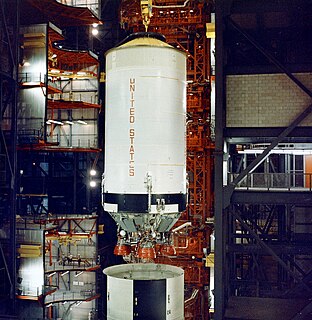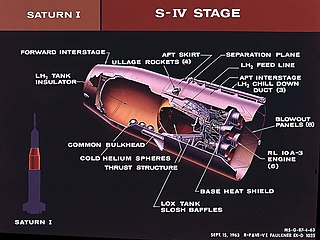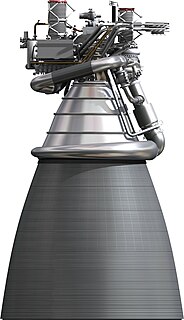Related Research Articles

The Centaur is a family of rocket propelled upper stages currently produced by U.S. launch service provider United Launch Alliance, with one main active version and one version under development. The 3.05 m (10.0 ft) diameter Common Centaur/Centaur III (as referenced in the infobox) flies as the upper stage of the Atlas V launch vehicle, and the 5.4 m (18 ft) diameter Centaur V is being developed as the upper stage of ULA's new Vulcan rocket. Centaur was the first rocket stage to use liquid hydrogen (LH2) and liquid oxygen (LOX) propellants, a high-energy combination that is ideal for upper stages but has significant handling difficulties.

Apollo 6, also known as AS-502, was the third and final uncrewed flight in the United States' Apollo Program, and the second test of the Saturn V launch vehicle. It qualified the Saturn V to be used on crewed missions, as happened for the first time on Apollo 8 in December 1968.

The S-IVB was the third stage on the Saturn V and second stage on the Saturn IB launch vehicles. Built by the Douglas Aircraft Company, it had one J-2 rocket engine. For lunar missions it was fired twice: first for Earth orbit insertion after second stage cutoff, and then for translunar injection (TLI).

Rocketdyne was an American rocket engine design and production company headquartered in Canoga Park, in the western San Fernando Valley of suburban Los Angeles, in southern California.

AS-201, flown February 26, 1966, was the first uncrewed test flight of an entire production Block I Apollo command and service module and the Saturn IB launch vehicle. The spacecraft consisted of the second Block I command module and the first Block I service module. The suborbital flight was a partially successful demonstration of the service propulsion system and the reaction control systems of both modules, and successfully demonstrated the capability of the command module's heat shield to survive re-entry from low Earth orbit.

The Saturn IB was an American launch vehicle commissioned by the National Aeronautics and Space Administration (NASA) for the Apollo program. It uprated the Saturn I by replacing the S-IV second stage, with the S-IVB. The S-IB first stage also increased the S-I baseline's thrust from 1,500,000 pounds-force (6,700,000 N) to 1,600,000 pounds-force (7,100,000 N) and propellant load by 3.1%. This increased the Saturn I's low Earth orbit payload capability from 20,000 pounds (9,100 kg) to 46,000 pounds (21,000 kg), enough for early flight tests of a half-fueled Apollo command and service module (CSM) or a fully fueled Apollo Lunar Module (LM), before the larger Saturn V needed for lunar flight was ready.

The S-II was the second stage of the Saturn V rocket. It was built by North American Aviation. Using liquid hydrogen (LH2) and liquid oxygen (LOX) it had five J-2 engines in a quincunx pattern. The second stage accelerated the Saturn V through the upper atmosphere with 1,000,000 pounds-force (4.4 MN) of thrust.

The S-IV was the second stage of the Saturn I rocket used by NASA for early flights in the Apollo program.

The Aerojet Rocketdyne RS-25, also known as the Space Shuttle Main Engine (SSME), is a liquid-fuel cryogenic rocket engine that was used on NASA's Space Shuttle. NASA is planning to continue using the RS-25 on the Space Shuttle's successor, the Space Launch System (SLS).

The F-1, commonly known as Rocketdyne F1, is a rocket engine developed by Rocketdyne. This engine uses a gas-generator cycle developed in the United States in the late 1950s and was used in the Saturn V rocket in the 1960s and early 1970s. Five F-1 engines were used in the S-IC first stage of each Saturn V, which served as the main launch vehicle of the Apollo program. The F-1 remains the most powerful single combustion chamber liquid-propellant rocket engine ever developed.

The J-2 was a liquid-fuel cryogenic rocket engine used on NASA's Saturn IB and Saturn V launch vehicles. Built in the U.S. by Rocketdyne, the J-2 burned cryogenic liquid hydrogen (LH2) and liquid oxygen (LOX) propellants, with each engine producing 1,033.1 kN (232,250 lbf) of thrust in vacuum. The engine's preliminary design dates back to recommendations of the 1959 Silverstein Committee. Rocketdyne won approval to develop the J-2 in June 1960 and the first flight, AS-201, occurred on 26 February 1966. The J-2 underwent several minor upgrades over its operational history to improve the engine's performance, with two major upgrade programs, the de Laval nozzle-type J-2S and aerospike-type J-2T, which were cancelled after the conclusion of the Apollo program.

The Rocketdyne H-1 is a 205,000 lbf (910 kN) thrust liquid-propellant rocket engine burning LOX and RP-1. The H-1 was developed for use in the S-I and S-IB first stages of the Saturn I and Saturn IB rockets, respectively, where it was used in clusters of eight engines. After the Apollo program, surplus H-1 engines were rebranded and reworked as the Rocketdyne RS-27 engine with first usage on the Delta 2000 series in 1974. The RS-27 variant is also used on the Delta II and Delta III.

The RL10 is a liquid-fuel cryogenic rocket engine built in the United States by Aerojet Rocketdyne that burns cryogenic liquid hydrogen and liquid oxygen propellants. Modern versions produce up to 110 kN (24,729 lbf) of thrust per engine in vacuum. Three RL10 versions are in production for the Centaur upper stage of the Atlas V and the DCSS of the Delta IV. Three more versions are in development for the Exploration Upper Stage of the Space Launch System and the Centaur V of the Vulcan rocket.

The J-2X is a liquid-fueled cryogenic rocket engine that was planned for use on the Ares rockets of NASA's Constellation program, and later the Space Launch System. Built in the United States by Aerojet Rocketdyne, the J-2X burns cryogenic liquid hydrogen and liquid oxygen propellants, with each engine producing 1,307 kN (294,000 lbf) of thrust in vacuum at a specific impulse (Isp) of 448 seconds (4.39 km/s). The engine's mass is approximately 2,470 kg, significantly heavier than its predecessors.

The Saturn II was a series of American expendable launch vehicles, studied by North American Aviation under NASA contract in 1966, derived from the Saturn V rocket used for the Apollo lunar program. The intent of the study was to eliminate production of the Saturn IB, and create a lower-cost heavy launch vehicle based on Saturn V hardware. North American studied three versions with the S-IC first stage removed: the INT-17, a two-stage vehicle with a low Earth orbit payload capability of 47,000 pounds (21,000 kg); the INT-18, which added Titan UA1204 or UA1207 strap-on solid rocket boosters, with payloads ranging from 47,000 pounds (21,000 kg) to 146,400 pounds (66,400 kg); and the INT-19, using solid boosters derived from the Minuteman missile first stage.
The Saturn C-2 was the second rocket in the Saturn C series studied from 1959 to 1962. The design was for a four-stage launch vehicle that could launch 21,500 kg (47,300 lb) to low Earth orbit and send 6,800 kg (14,900 lb) to the Moon via Trans-Lunar Injection.
The C-2 design concept was for a proposed crewed circumlunar flight and the Earth orbit rendezvous (EOR) missions. It was initially considered for the Apollo lunar landing at the earliest possible date (1967).

The AJ10 is a hypergolic rocket engine manufactured by Aerojet Rocketdyne. It has been used to propel the upper stages of several launch vehicles, including the Delta II and Titan III. Variants were and are used as the service propulsion engine for the Apollo command and service module, in the Space Shuttle Orbital Maneuvering System, and on NASA's Orion spacecraft.

Saturn V was an American human-rated super heavy-lift launch vehicle used by NASA between 1967 and 1973. A three-stage, liquid-fueled rocket, the Saturn V was developed under the Apollo program for human exploration of the Moon and was later used to launch Skylab, the first American space station.
This page is an incomplete list of orbital rocket engine data.
The Rocketdyne S-3D is an American liquid rocket engine produced by Rocketdyne between 1956 and 1961 for use on the PGM-19 Jupiter and PGM-17 Thor missiles, and the Juno II rocket. Its design was used later as the basis for the H-1 rocket engine of the Saturn I, and the Rolls-Royce RZ.2 of the Blue Streak.
References
- 1 2 3 4 5 Mark Wade (17 November 2011). "HG-3". Encyclopedia Astronautica. Archived from the original on 15 November 2011. Retrieved 18 February 2012.
- 1 2 Mark Wade (17 November 2011). "HG-3-SL". Encyclopedia Astronautica. Archived from the original on 17 November 2011. Retrieved 18 February 2012.
- ↑ "MSFC Propulsion Center of Excellence is Built on Solid Foundation". NASA. 1995. Archived from the original on 27 April 2015. Retrieved 13 December 2011.